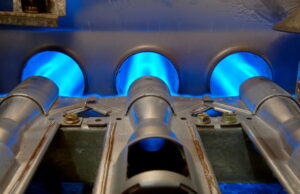
The first thing you should know about a cracked heat exchanger in a gas furnace is that you don’t want one!
Gas furnaces are not inherently dangerous devices—something we should clear up right away. However, if you don’t take proper care of your gas furnace, it can become dangerous. Just like any other powerful appliance or appliance that creates combustion gasses, a furnace can potentially create health hazards if it is not properly maintained on a consistent basis.
What we want to caution you about today is one of the most common causes for a gas furnace becoming unsafe. Cracked heat exchangers are more likely to occur in older furnace systems (10-15 years old), so we recommend looking into a replacement sooner than later if you have an aging system. Routine maintenance does help catch problems like this before they start! Be sure to call for maintenance if you skipped it in the fall.
In the meantime, read on to learn more about heat exchangers in gas furnaces.
First Off, What’s a Heat Exchanger?
This is one of the most important components in your furnace, if not the most important. It’s the device actually responsible for transferring heat to the air that gets blown into your living space. The combustion gas cannot come into direct contact with your indoor air, otherwise, potentially harmful fumes such as carbon monoxide can make their way into your home.
Instead, combustion gases enter the heat exchanger, which is a metal, clamshell-shaped chamber. The heat from the combustion gases raises the temperature of the metal, and when the air from the blower passes around it, heat transfers to it. Basically, the heat exchanger is where your furnace heats.
The Problem with a Cracked Heat Exchanger
When a heat exchanger is damaged, it allows the exhaust fumes inside the exchanger to leak into your breathable air. The most toxic of these fumes is CO, or carbon monoxide. CO poisoning leads to hundreds of illnesses and fatalities each year, and is nothing to take lightly.
The most likely cause for a damaged heat exchanger is corrosion. What happens is that there is a natural reaction between the combustion gas and the metal, and over time this causes a weakening of the metal. This is why it’s something important to watch out for in an older furnace. Even a small crack is a problem, since it will stretch wider as the heat exchanger turns hot and expands.
You may notice a clicking noise coming from your furnace after the blower shuts off. This can be indicative of an already cracked heat exchanger contracting as it cools down. If you do discover this, or if one of your CO detectors goes off in your home, the best thing you can do is shut off your furnace and give our team a call right away.
Can a Damaged Heat Exchanger Be Replaced?
Yes, but that doesn’t always mean it should be. What we mean is, if your cracked heat exchanger is in an older furnace, where it’s most common, it’s best to replace the system as a whole because this is just one of the many problems that affect the efficacy and efficiency of furnaces.
If, however, your furnace is on the newer side and you’ve kept up with maintenance, then there’s a chance this was a manufacturer defect, and you should certainly look into replacing the component rather than the entire furnace.
Contact Brown’s Heating & Cooling today for quality furnace repair in Monument, CO.
